
USS Minnesota was a wooden steam frigate in the United States Navy. Launched in 1855 and commissioned eighteen months later, the ship served in east Asia for two years before being decommissioned. She was recommissioned at the outbreak of the American Civil War and returned to service as the flagship of the North Atlantic Blockading Squadron.

The first USS Rhode Island was a side-wheel steamer in the United States Navy, commissioned in 1861.

USS Advance, the second United States Navy ship to be so named, was later known as USS Frolic, and was originally the blockade runner Advance captured by the Union Navy during the latter part of the American Civil War. She was purchased by the Union Navy and outfitted as a gunboat and assigned to the blockade of the waterways of the Confederate States of America. She also served as dispatch ship and supply vessel when military action eventually slowed.

The first USS Pawnee was a sloop-of-war in the United States Navy during the American Civil War. She was named for the Pawnee Indian tribe.
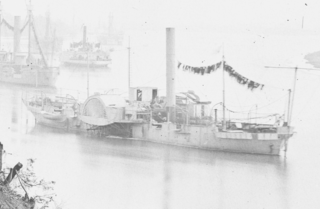
The first USS Miami was a side-wheel steamer, double-ender gunboat in the United States Navy during the American Civil War.

USS Ceres was a small 150-long-ton (152 t) steamboat acquired by the Union Navy during the beginning of the American Civil War. She was outfitted as a gunboat and used in the Union blockade of the waterways of the Confederate States of America.

The first USS Sassacus, a wooden, double-ended, sidewheel steamer in commission in the United States Navy from 1863 to 1865. She saw service in the American Civil War.
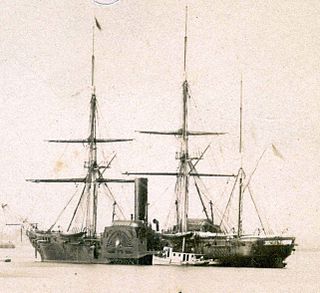
USS Susquehanna, a sidewheel steam frigate, was the first ship of the United States Navy to be named for the Susquehanna River, which rises in Lake Otsego in central New York and flows across Pennsylvania and the northeast corner of Maryland emptying into the Chesapeake Bay.
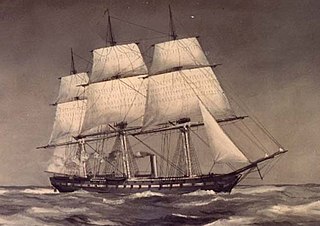
USS Wabash was a steam screw frigate of the United States Navy that served during the American Civil War. She was based on the same plans as Colorado. Post-war she continued to serve her country in European operations and eventually served as a barracks ship in Boston, Massachusetts, and was sold in 1912.

USS Richmond was a wooden steam sloop in the United States Navy during the American Civil War.

USS Stars and Stripes was a 407-ton steamer acquired by the U.S. Navy and put to use by the Union during the American Civil War.

The first USS Pocahontas, a screw steamer built at Medford, Massachusetts in 1852 as City of Boston, and purchased by the Navy at Boston, Massachusetts on 20 March 1855, was the first United States Navy ship to be named for Pocahontas, the Algonquian wife of Virginia colonist John Rolfe. She was originally commissioned as USS Despatch – the second U.S. Navy ship of that name – on 17 January 1856, with Lieutenant T. M. Crossan in command, and was recommissioned and renamed in 1860, seeing action in the American Civil War. As Pocahontas, one of her junior officers was Alfred Thayer Mahan, who would later achieve international fame as a military writer and theorist of naval power.
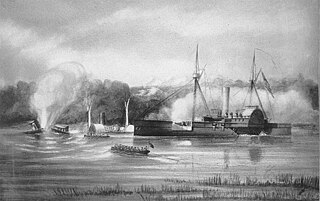
USS Wyalusing was a double-ended, side-wheel gunboat that served in the United States Navy during the American Civil War. She was named for the borough of Wyalusing in Bradford County, Pennsylvania.

USSWhitehead, a screw steamer built in 1861 at New Brunswick, New Jersey, served as a gunboat in the United States Navy during the American Civil War.
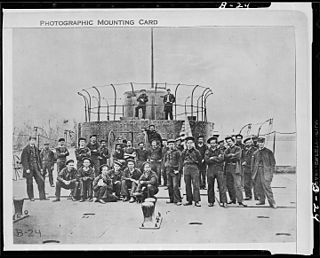
The first USS Lehigh was a Passaic-class monitor launched 17 January 1863 by Reaney, Son & Archbold, Chester, Pennsylvania, under a subcontract from John Ericsson; and commissioned at Philadelphia Navy Yard 15 April 1863, Commander John Guest in command.

USS Howquah was a screw steamer purchased by the Union Navy in Boston from G. W. Upton on 17 June 1863, for action against Confederate commerce raider CSS Tacony which was then preying upon Northern merchantmen during what Professor Richard S. West has called "the most brilliant daredevil cruise of the war."
USS Western World was a ship acquired by the Union Navy during the American Civil War. She was used by the Navy to patrol navigable waterways of the Confederacy to prevent the South from trading with other countries.
USS Shamrock was a large seaworthy steamer with powerful guns, acquired by the Union Navy during the American Civil War. She was used by the Union Navy as a gunboat in support of the Union Navy blockade of Confederate waterways.
USS State of Georgia was a large steamer with powerful guns acquired by the Union Navy during the American Civil War. State of Georgia, with her crew of 113 sailors and officers, was used by the Union Navy as a gunboat in its blockade of Confederate waterways.

Michael C. Horgan was a Union Navy sailor in the American Civil War who served under the alias Martin Howard. He received the United States military's highest decoration, the Medal of Honor, for his actions during the capture of Plymouth, North Carolina.


















